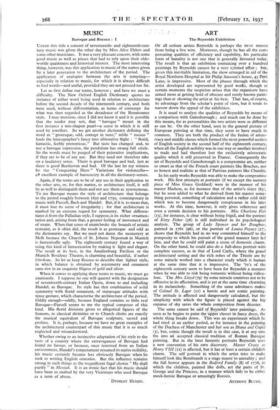ART
The Reynolds Exhibition .
Or all serious artists Reynolds is perhaps the most remote from being a live wire. Moreover, though he has all the com- pensating qualities of efficiency and capability, his particular forth of banality is not one that is generally faVOtired *today. The result is that an exhibitiOn • containing over a htindked paintings by Reynolds cannot be a very s2irited affair ; given this inevitable limitation, the show arranged in. aid of the Royal Northern Hospital at Sir Philip Sassoon's house, 45 Park Lane, is impressive. Most of the phases through which the artist developed are represented by good works, though at certain moments the suspicion 'arises that the- Organisers have aimed more at getting hold of obscure and rarely known paint- ings than at showing the artist at his best. That has, of course, its advantage from the scholar's point of view, but it tends to narrow down the appeal of the exhibition.
It is usual to analyse the qualities of Reynolds by means of a comparison with Gainsborough ; and much can be done by this means, for as personalities the two artists were as different as can be.' On the other hand, seen in the general picture of European painting at that time, they seem to haire much in common. They are both the product of the fusion of aristo- cracy and middle classes which formed the most powerful section of English society in the second half Of the eighteenth century, when all the English nobility was in one way or another involved in trade and had therefore lost the exclusively aristocratic quality which it still preserved in France.' Consequently the art of Reynolds and Gainsborough is a cornprothise art, neither so smart as that of the French court painters like Boucher, nor so honest and realistic as that of Parisian painters like Chardin.
In his early works Reynolds was able to make the compromise work. His first attempts at portraits (if we except the nursery piece of Miss Grace Goddard) were in the manner of his master Hudson, as for instance that of the artist's sister (65), but he soon added to what he derived from his master some- thing personal, something of calculation and a rather cold skill which was to become dangerously conspicuous in hii later works. At this time, however, it only gives coherence and even a certain decision to his portraits. Miss Charlotte Fish (13), for instance, is clear without being frigid, and the portrait of Kitty Fisher (58) is • still individual in its psychological analysis. The group of Lady Spencer and her Daughter, painted in 1761 (96),*or the portrait of Louila Poyntz (27), shows that Reynolds had in no way committed himself to the pomposity to which his pursuit of the grand manner later led him, and that he could still paint a scene of domestic charm. On the other hand, he 'could also do a full-dress portrait with complete success, as in that of Lord Carlis, where the grand architectural setting and the rich robeS Of the Thistle are by some miracle worked - into a character study which is hunian at the same time that it is impressive. The '70's of _the eighteenth century seem to have been for Reynolds a moment when he was able to risk being romantic without being ridicu- lous. The Mrs. Lloyd (79) by some miracle contrives not to be offensive in its affectation, and is yet at the same time charining in its melancholy. Something of the same adroitness makes of Colonel St. Leger (ii) a heroic and not comic painting. The attitude is affected and dangerously' calculated, but the simplicity with' which the figure is .pliced againit the big expanse of sky saves -the *hole coinposition from diiaster.
The same cannot be said 'of Rep:Mk:le liter paintings. As ,
soon as he begins to paint the-Vpper classes in fancy.dress, the whole thing breaks dOwn. This was an eXperiment which he had tried at an earlier period, as for instance in the painting of the Duchess of Manchester and her" son as Diand and Cupid (3), but, comic though the result is in this case, it at any rate fits into an accepted classical tradition of Roman BaroqUe painting. But in the latei fantastic :portraits Reynolds 'uses a' new Convention of his own discovery. Master Crewe 'as Henry VIII (i2) is affected, but it hai at least a certain childish charm. The self 'portrait in which the artist tries 'to Make himself lOok like Rembrandt is a stage nearer to unreality ;• and the fidi horror aPpears in the Bedford Faritily (8) of 1776; in Which the children, painted like dolls, act the parts of St. George and the Princess, in a Manner which faili to be either
o e oq Mock-heroic Baru or amusingly Rococ. ' • • •














































 Previous page
Previous page